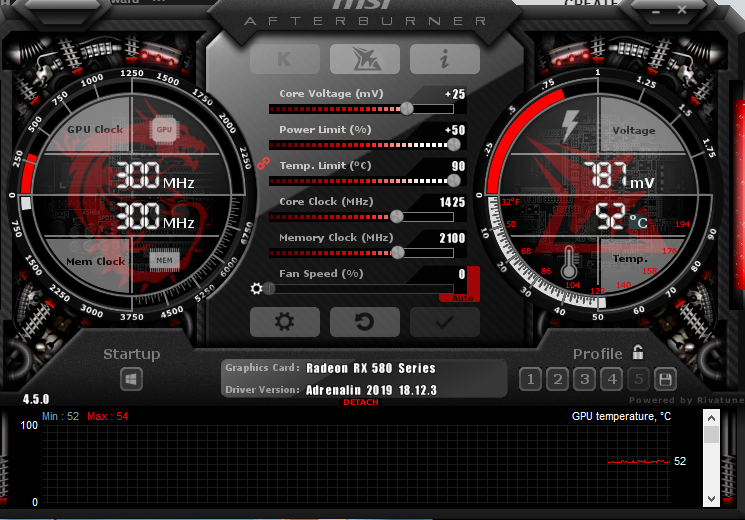- Sapphire Red Line Voltage Tweaker Tool Download
- Sapphire Red Line Voltage Tweaker Tool Kit
- Line Voltage Definition
Megatron
- Joined
- Sep 19, 2005
- Messages
- 150 (0.03/day)
| System Name | Homebrew |
|---|---|
| Processor | Intel I5 4690k>Ryzen3900x |
| Motherboard | Gigabyte Z97X-Gaming 5>Aorus Elite X570 |
| Cooling | CPU: (Prolimatek Megahelim 2+1 exhaust fan)>X72 Kraken, GPU: 570lx 240mm AIO w/kraken G10 + Ramsinks |
| Memory | Kingston Hyper-X 2400 Savage 2 x 8Gb>16GB Corsair Vengence Pro M2Z(for Ryzen)>32GB PatriotViper 4400 |
| Video Card(s) | Sapphire RX Vega 56 HBM to 930Mhz from 800Mhz for Gaming & 850 for Gigapixel AI |
| Storage | 850 evo 250Gb, 860 1TB, HGST HDN726040ALE640, WD10EACS 1Tb, WD20EARS 2Tb, WD80EMAZ, WD140EMFZ |
| Display(s) | Benq GW2265>C24FG73 Samsung 144Hz |
| Case | Antec P180>Lian-Li 011 Dynamic XL |
| Audio Device(s) | Asus Xonar DX |
| Power Supply | Corsair HX850 |
| Mouse | Gigabyte M6900> Razer Deathadder V2 (optical switches) |
| Keyboard | Logitech G15 + Wolfking circular gaming KB |
| Software | Windows 7 SP1>Windows 10 Pro N fully activated with gatherosstate.exe |
| Benchmark Scores | http://www.doomiii.pwp.blueyonder.co.uk/system-spec.html < Need a new host |
I have set it to 850/1100 with stock cooler without any problem. I think that with this new cooling setup I should have a higher GPU voltage (even though I know the card is memory bound).
I would have been ok with using 3rd party apps like Afterburner plus Asus Smart Doctor, but its not possible because SD has no support and GPU tweak doesn't support 6850 voltage change. There are google results about while using BF3 + Smart Doctor game crashes between round, which is what I experienced.
I've tried Asus GPUtweak (Smartdoctor), MSI afterburner(while doing the unofficial overclocking ini tweak) to get a soft volt mod but not Sapphire Trixx or any other tool.
So I need another way of bumping the GPU voltage. I've not got to the limit of CCC so I'll cross that bridge when I reach it.
I've read a few posts here and there about Racer-x(http://www.techpowerup.com/forums/threads/push-overdrive-limits-over-the-top.141858/) and that if you mod the 6850 bios it will BSOD on windows boot.
However I'm a bit late to the party and I don't see a large thread of users all using the same method.
So atm bearing in mind I can't soft mod the voltage and the problem with modding the 6850 bios, it would be the best bet to flash a 6870 bios. I think it might be possible to mod the 6850 bios voltage registers but it would take nerves of steal to do this, rather than just use a manufacturer's pre made bios.
This is the bios I'm using currently:
http://www.techpowerup.com/vgabios/129472/asus-hd6850-1024-110616-2.html
and this is the bios I'm thinking of flashing:
http://www.techpowerup.com/vgabios/109702/asus-hd6870-1024-110719.html
http://www.techpowerup.com/forums/threads/how-to-use-atiflash.57750/
Has anyone tried this already or am a missing a better way. Note: My card has 2 power connectors (as I was reading another topic where someone said it wouldn't have enough power)
Edit:
I tried this bios:
http://www.techpowerup.com/vgabios/100395/asus-hd6870-1024-101228.html
and it was incompatible, so save yourself the bother. I got my card working again following the bad flash guide sticky which I hope has been updated to reflect that the default display adapter must be selected in the motherboard bios and that if you want to use integrated graphics a cmos bios reset sets PCI-E as default. I only tested the reset with the PCI-E slot occupied so it may default to intergrated if no PCI-E adapter is found after a CMOS reset.
Sapphire Atlantis Radeon 9600 Pro
Company: Sapphire
Product: Atlantis Radeon 9600 Pro
Street Price: ~$165
Date Reviewed: June 17, 2003
Reviewed By: Joey Chao
Bundle and Features:
The rest of the bundle is very well put together. Included in the bundle are the necessary cables and connectors like the DVI-to-VGA converter, S-VHS lead, S-VHS-to-composite converter, and composite lead. All the cables are important for using the DVI or TV-out functions provided by the video card.
The software bundle with the Sapphire 9600 Pro is very interesting. Of course you get the drivers CD but you also get Cyberlink's Power DVD which some of you may recognize from other video card bundles and/or motherboards. Another great software utility provided with the package is the Redline Overclocking/Tweak utility. This software makes is easy to overclock and tweak the video card. It is very similar to Rage3D Tweaker if you are familiar with that program.

